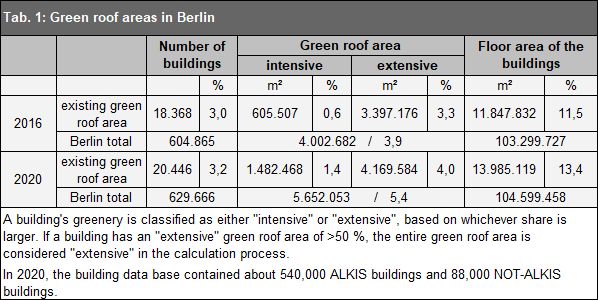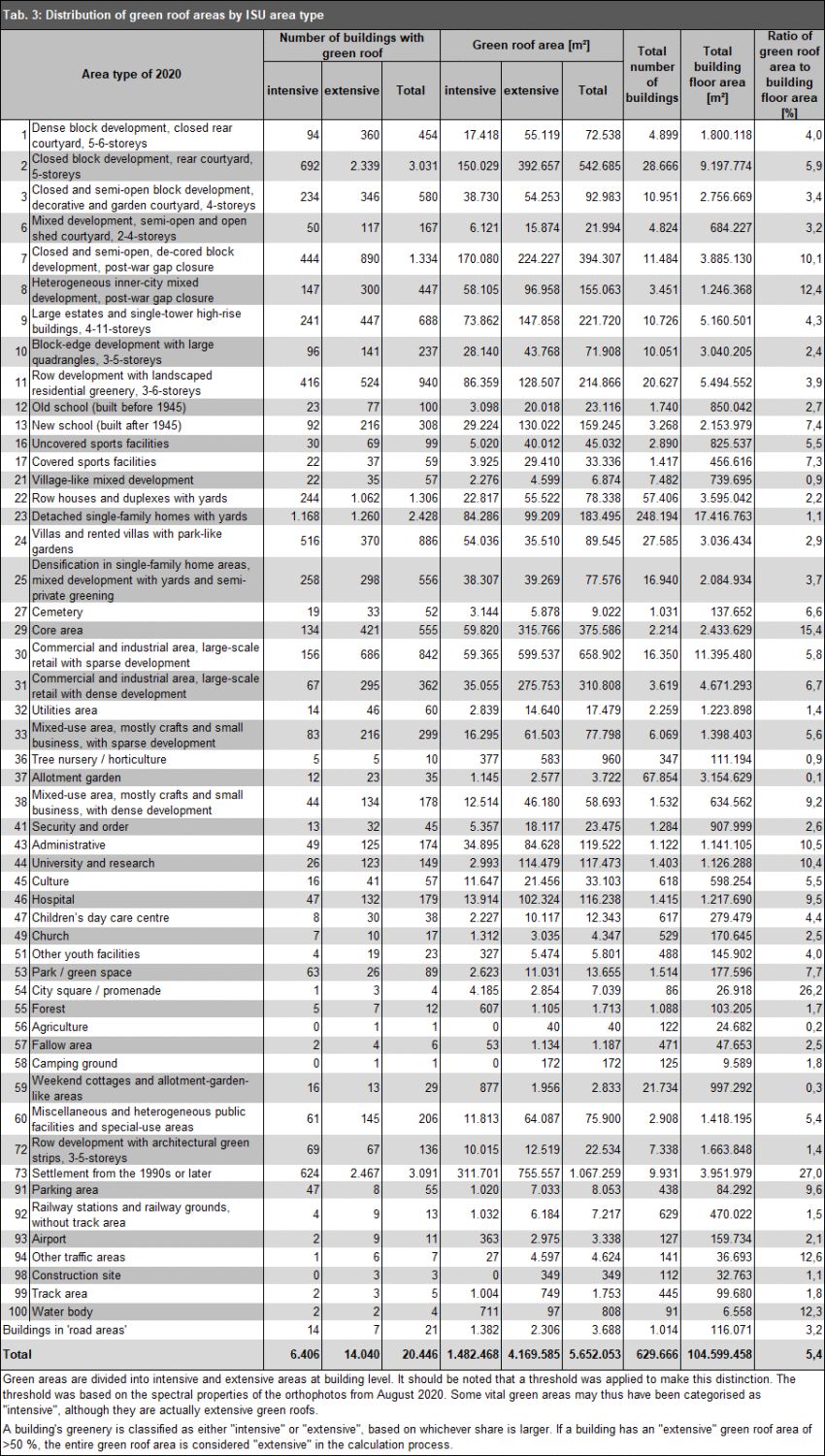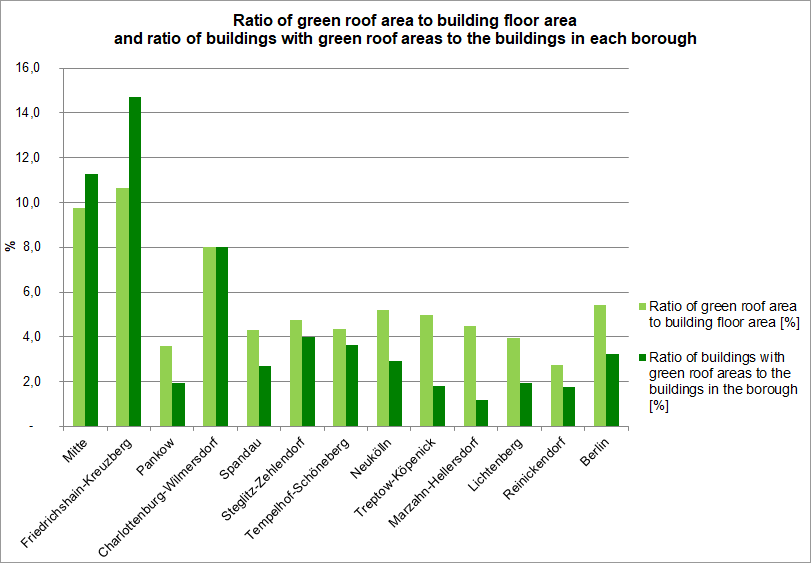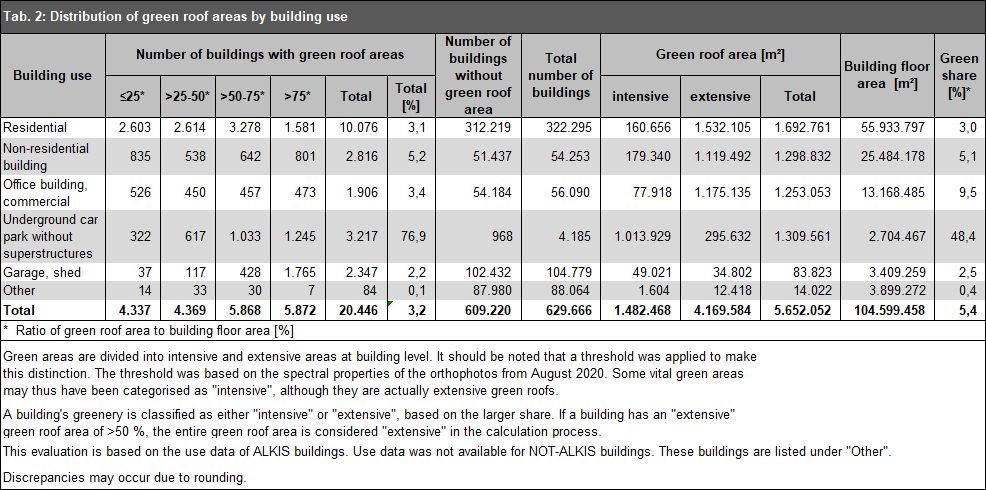In Berlin, there are 629,666 buildings, 20,446 (3.2%) of which are underground car parks without superstructures featuring green roofs or green roof areas larger than 10 m². In total, 656 ha of all roof areas are greened (5.4 %) (Tab. 1). Since 2016, the number of buildings with green roofs has therefore increased by 0.2 %. The ‘green roof’ area share even rose from 3.9 % to 5.4 %. Overall, the green roof area grew by 165 ha. A look at the map reveals that green roof areas are concentrated in the inner city of Berlin.
Green Roofs 2020

Tab. 1: Green roof areas in Berlin in 2016 and 2020
Image: Umweltatlas Berlin
![Fig. 3: Green roof area [m²] – share by building use class, 2020](/imgscaler/8BZXIRLuRbLpyIDPkFlzAaMLQ0LwkC_bkMYSdopM89I/ropen/L3N5czExLXByb2QvdW13ZWx0YXRsYXMvX2Fzc2V0cy9udXR6dW5nL2dydWVuZGFlY2hlci9lbi1hYmJpbGR1bmdlbi9lYTYxMV8wM18yMDIwLnBuZw.png?ts=1681473662)
Fig. 3: Green roof area [m²] – share by building use class, 2020
Image: Umweltatlas Berlin

Tab. 3: Distribution of green roof areas by ISU area type
Image: Umweltatlas Berlin
![Fig. 4: Green roof area [m²] by borough, categorised by green roof area share [%], 2020](/imgscaler/fe_d3s9jfLDPUKG16thSPmoK9aiRe0Qfyi0m-XuEDcA/ropen/L3N5czExLXByb2QvdW13ZWx0YXRsYXMvX2Fzc2V0cy9udXR6dW5nL2dydWVuZGFlY2hlci9lbi1hYmJpbGR1bmdlbi9lYTYxMV8wNF8yMDIwLnBuZw.png?ts=1681473650)
Fig. 4: Green roof area [m²] by borough, categorised by green roof area share [%], 2020
Image: Umweltatlas Berlin

Fig. 5: Ratio of green roof area to building floor area and ratio of buildings with green roof areas to the buildings in each borough, 2020
Image: Umweltatlas Berlin
![Fig. 6: Green roof area [m²] by borough, distinguishing between "intensive" and "extensive" greenery, 2020](/imgscaler/WOPUb34yDehYiFz2bjr-CjOzSh4Hi33IFybT4t_LKJw/ropen/L3N5czExLXByb2QvdW13ZWx0YXRsYXMvX2Fzc2V0cy9udXR6dW5nL2dydWVuZGFlY2hlci9lbi1hYmJpbGR1bmdlbi9lYTYxMV8wNl8yMDIwLnBuZw.png?ts=1681473660)
Fig. 6: Green roof area [m²] by borough, distinguishing between "intensive" and "extensive" greenery, 2020
Image: Umweltatlas Berlin


![Enlarge photo: Tab. 4: Distribution of green roof areas by borough (* Ratio of green roof area to building floor area [%])](/imgscaler/OVGyO18wxLeoLrP-_A4DCB0QyMz8Nh5RsikvKHfrABc/ropen/L3N5czExLXByb2QvdW13ZWx0YXRsYXMvX2Fzc2V0cy9udXR6dW5nL2dydWVuZGFlY2hlci9lbi10YWJlbGxlbi9ldDYxMV8wNF8yMDIwLmdpZg.jpg?ts=1681473656)